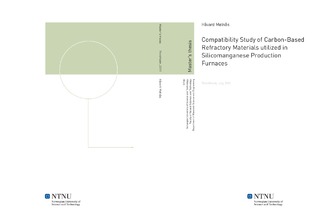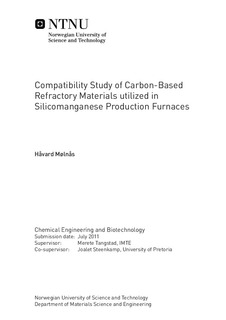| dc.description.abstract | Tap hole refractories constitute critical parts of the refractory lining in submerged arc furnaces. For several hours every day, molten slag and metal flow through the tap hole calling for thorough selection of refractory materials able to withstand the intense thermal, corrosive and erosive conditions present in this area. Carbon-based refractories have shown excellent thermal properties and high strength, as well as low wettability towards process materials, and are therefore utilized in silicomanganese production furnaces both as side lining, in the hearth, and in the tap hole area. The aim of this investigation was to determine the compatibility of five refractory materials utilized in the tap hole area of an industrial silicomanganese furnace with two industrial silicomanganese slags: Investigate the suitability of the selected refractory materials for confining the process materials during industrial production of silicomanganese alloys. Identify critical refractory wear mechanisms upon slag-refractory interaction at industrial tapping temperatures.Compatibilities were investigated through 12 static crucible tests and two static plate tests in a vertical tube furnace redesigned during this investigation. Slag-refractory interaction was studied after two and four hours holding time at 1367°C ± 1.8°C, 1464°C ± 2.1°C and 1600°C - 0.6°C /+ 0.2°C. Holding temperatures were verified through the wire-bridge method at the melting points of gold and palladium. Visual inspection, as well as optical microscopy and SEM, were utilized to examine the samples after heat treatment.During compatibility experiments, dissolution of refractory matrix due to solubility of oxide refractory binder phases in silicomanganese slags was observed, as well as disintegration of refractory particles due to gas formation at slag-refractory interface, or expansion as a result of phase transformations in refractory material. Direct reduction of manganese oxide from slags and iron oxide present in refractories by carbon and silicon carbide was also observed. Establishment of partial slag-metal equilibriums between iron oxide and silicon metal originally present in slag was observed, as well as formation of silicon carbide at the slag-refractory interfaces. The latter may serve to protect the refractory from wear caused by slags.Based on observations of extensive interaction between silicomanganese slag sample I and ramming paste at 1600°C, the ramming paste investigated cannot be recommended for usage during tap block repair in an industrial silicomanganese furnace. Incipient electrode paste disintegration by slags and silicon carbide tap block slag interaction were observed after compatibility tests at 1464°C, calling for further investigations of these refractory materials. Tap hole clay and carbon tap block showed minimal signs of interaction with process materials at 1464°C. Refractory porosity seemed to have a larger effect on refractory wear than refractory ash content. Contrary to industrial observations, silicomanganese slag sample I was more corrosive towards the ramming paste and electrode paste investigated than silicomanganese slag sample II. | nb_NO |

